Crayfish may not intrigue most snakes. However, there are a few unique snakes that specialize in eating these small, freshwater crustaceans, even with their hard shells and large, pinching claws. In fact, the crayfish snake (Liodytes rigida) gets its name from its love of these miniature lobster-like creatures. This snake almost exclusively eats crayfish! How does a snake stomach these crunchy critters? Let’s take a closer look at this unique snake and discover the largest crayfish snake ever found.
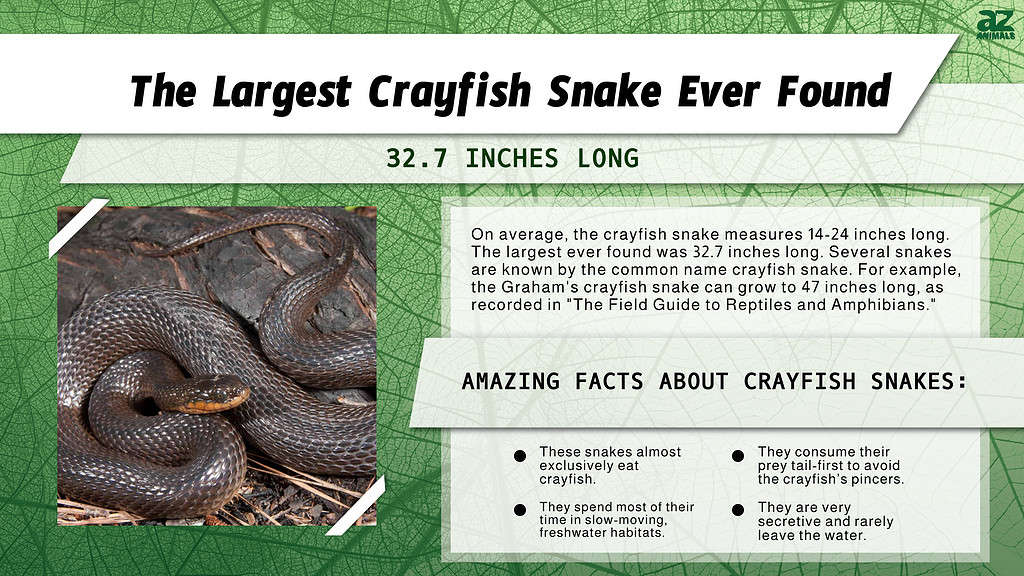
What Do Crayfish Snakes Look Like?
The crayfish snake is typically brown, dark brown, or olive in color. These snakes are relatively small, although the largest crayfish snake ever found was much longer than average. Crayfish snakes have very glossy bodies, even though their scales are actually keeled or ridged. Because of this, crayfish snakes are sometimes called “glossy swampsnakes” as well. In some snakes, you can see two dark stripes running along their backs. However, these stripes are faint and often very difficult to see. The crayfish snake has a stout body and a short head with a fairly blunt snout and large eyes. It is the snake’s belly, however, that is its most identifiable feature. Crayfish snakes have cream or yellowish bellies with two rows of dark blotches in the form of half-moons or triangles. These small blotches run in two lines down the snake’s belly, one on each side of its midline.

Crayfish snakes have a very smooth, glossy appearance.
©Nathan A Shepard/Shutterstock.com
What Is the Largest Crayfish Snake Ever?
The crayfish snake is a small to medium-sized snake. On average, this snake measures between 14 and 24 inches in length. However, the longest crayfish snake ever found was 32.7 inches long!
It’s important to note that several snakes are known by the common name crayfish snake. For example, the Graham’s crayfish snake (Regina grahamii) has a maximum recorded length of more than a foot longer at 47 inches! This record length comes from The Field Guide to Reptiles and Amphibians.
- Includes detailed descriptions of nearly 600 reptile and amphibian species and subspecies
- Features over 600 full-color illustrations and nearly 400 drawings for accurate identification in the field
- In addition, hundreds of color photos and over 300 distribution maps accompany the species descriptions
- Each description provides specific details, such as weight, size, color, and identifiers that are unique to the species
Where Do Crayfish Snakes Live?
Crayfish snakes live in the coastal plains of the southeastern United States. These snakes are mostly aquatic and spend most of their time in slow-moving, freshwater habitats. Crayfish snakes live in marshes, cypress swamps, wetlands, bays, ditches, and ponds or lakes with lots of vegetation. Some snakes will also move into brackish water and spread into new rivers and river systems. Because of this, their populations can be sporadic and hard to track. These snakes are also extremely secretive and very rarely leave the water. On rare occasions, crayfish snakes cross the road or hide under moist logs, but usually only during a rainstorm or shortly afterward.
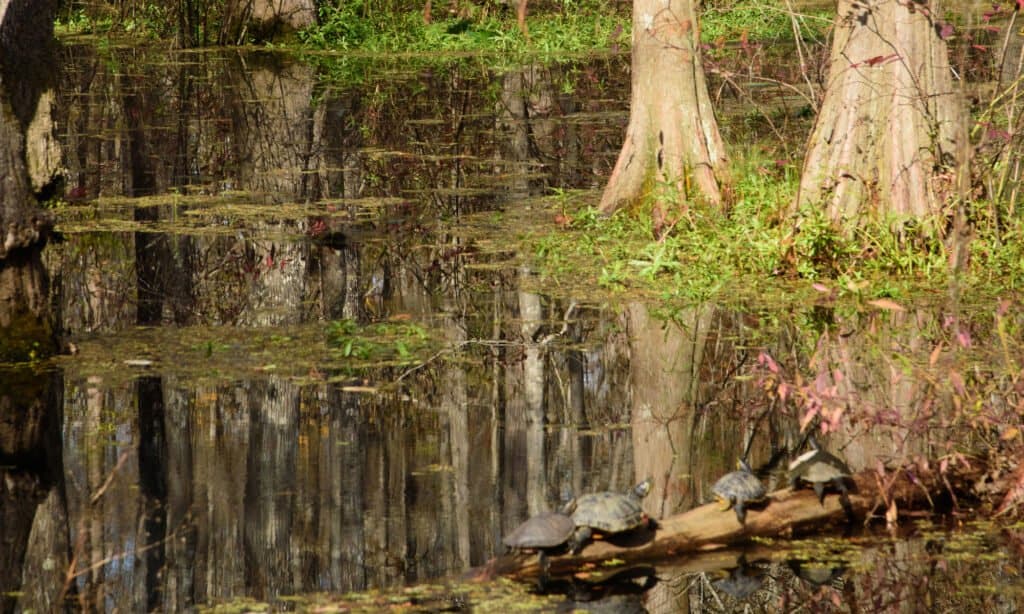
Crayfish snakes live in freshwater habitats with slow-moving water.
©Judy M Darby/Shutterstock.com
Are Crayfish Snakes Dangerous?
Crayfish snakes spend most of their lives in the water and rarely encounter humans. These snakes are extremely secretive and hard to find, even by experienced herpetologists, so we do not know a lot about their behavior. However, we do know that crayfish snakes are nonvenomous and harmless to humans. When these snakes feel threatened, they will try to escape and release a foul-smelling musk from their anal glands. Some snakes will also hiss and pretend to strike at the threat. However, it is very rare for a crayfish snake to actually bite.
Springtime is mating season for crayfish snakes, and they mate underwater. Female snakes give live birth underwater to six to 14 babies sometime during the summer or early fall. Baby crayfish snakes look very similar to the adults, except that they have pinkish-colored bellies instead of yellow.
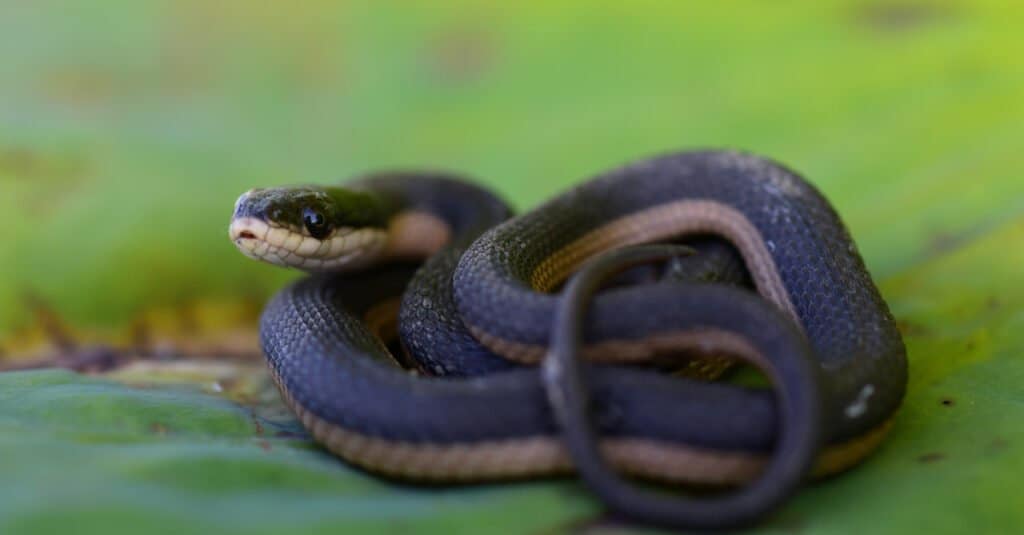
Crayfish snakes are extremely secretive and rarely encounter humans.
©Rusty Dodson/Shutterstock.com
What Do Crayfish Snakes Eat?
The crayfish snake gets its name from its unique diet — this snake almost exclusively eats crayfish! On occasion, a crayfish snake may eat an amphibian or small fish, but it is not as common. These hunting snakes eat all kinds of crayfish. They have teeth shaped like small chisels that help them to bite the hard shells of these small crustaceans. Sometimes crayfish snakes will utilize crayfish burrows for shelter after consuming the former residents.
There are a few techniques that a crayfish snake may utilize to eat these hard-shelled animals. Often these snakes swallow crayfish whole. However, instead of swallowing it headfirst like most snakes, the crayfish snake eats its prey tail first. This allows the snake to mostly avoid the crayfish’s awkward pincers. Smaller crayfish snakes that have trouble gripping and swallowing difficult crayfish take an alternative approach to mealtime. These snakes constrict the crayfish with their tails and grip it with their chisel-shaped teeth, tearing off small chunks of the crayfish at a time.
Baby crayfish snakes, on the other hand, are too small to tackle adult crayfish, so they primarily eat dragonfly naiads or aquatic nymphs. These are actually much more nutritious than crayfish, making them an excellent meal for young, developing snakes. Adult crayfish snakes, however, do not bother with aquatic nymphs because they do not provide enough calories to sustain the adult snake’s larger body.
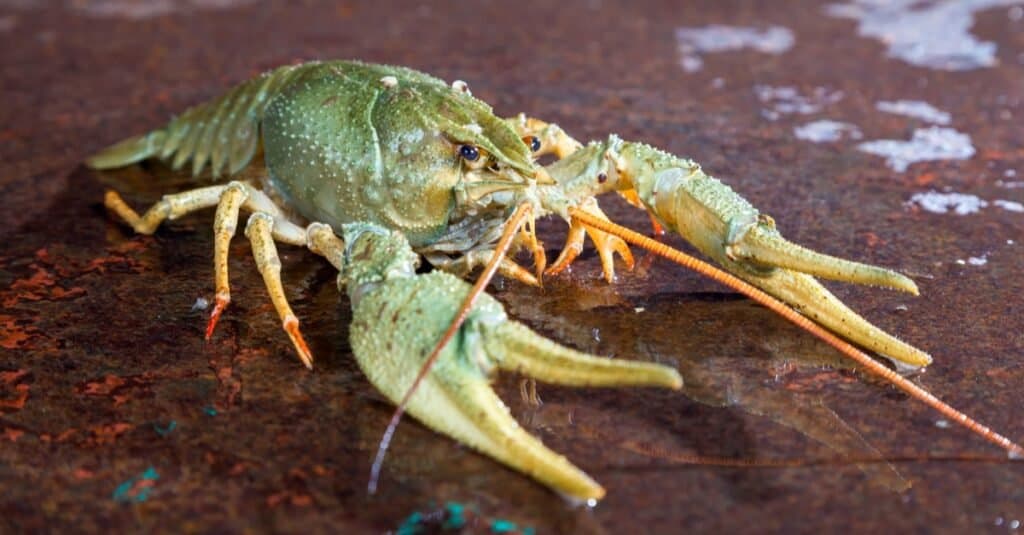
More than 350 species of the 500 crayfish species of the world live in the United States.
©Sergey Lavrentev/Shutterstock.com
Conservation Status
Because the crayfish snake is extremely secretive and lives primarily in the water, it is hard to get an accurate estimate of its overall population. We do not know for sure if there is a small population of snakes, or if they are just simply difficult to locate. However, there are many conservational concerns because the crayfish snake relies so heavily on aquatic environments in the southern United States. Many of the swamps and wetlands where these snakes live are continuously converted into farmland and urban development. In Georgia, state laws protect the crayfish snake.
Another concern is the crayfish’s primary food source: the crayfish. Many different species of crayfish are vulnerable as they face threats like urban development, pollution, water development and management, and logging. Because the crayfish snake relies so heavily on crayfish colonies for its survival, it is also vulnerable to these disruptions in the ecosystem.
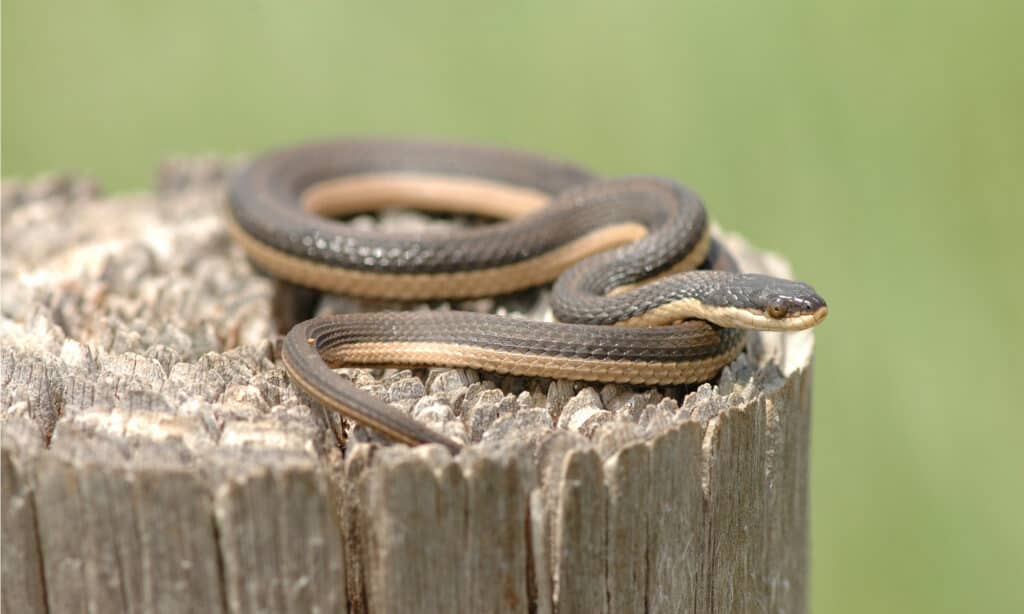
Many crayfish snake habitats are converted into farmland or urban development.
©Rusty Dodson/Shutterstock.com
Crayfish Snake vs. Queen Snake
Many people often mistake crayfish snakes for the queen snake. Queen snakes also spend much of their time in the water and eat crayfish. Their bodies are brown, olive, or gray. However, the queen snake has long yellowish stripes that run down each side its slender body. These markings make the queen snake look like a garter snake.
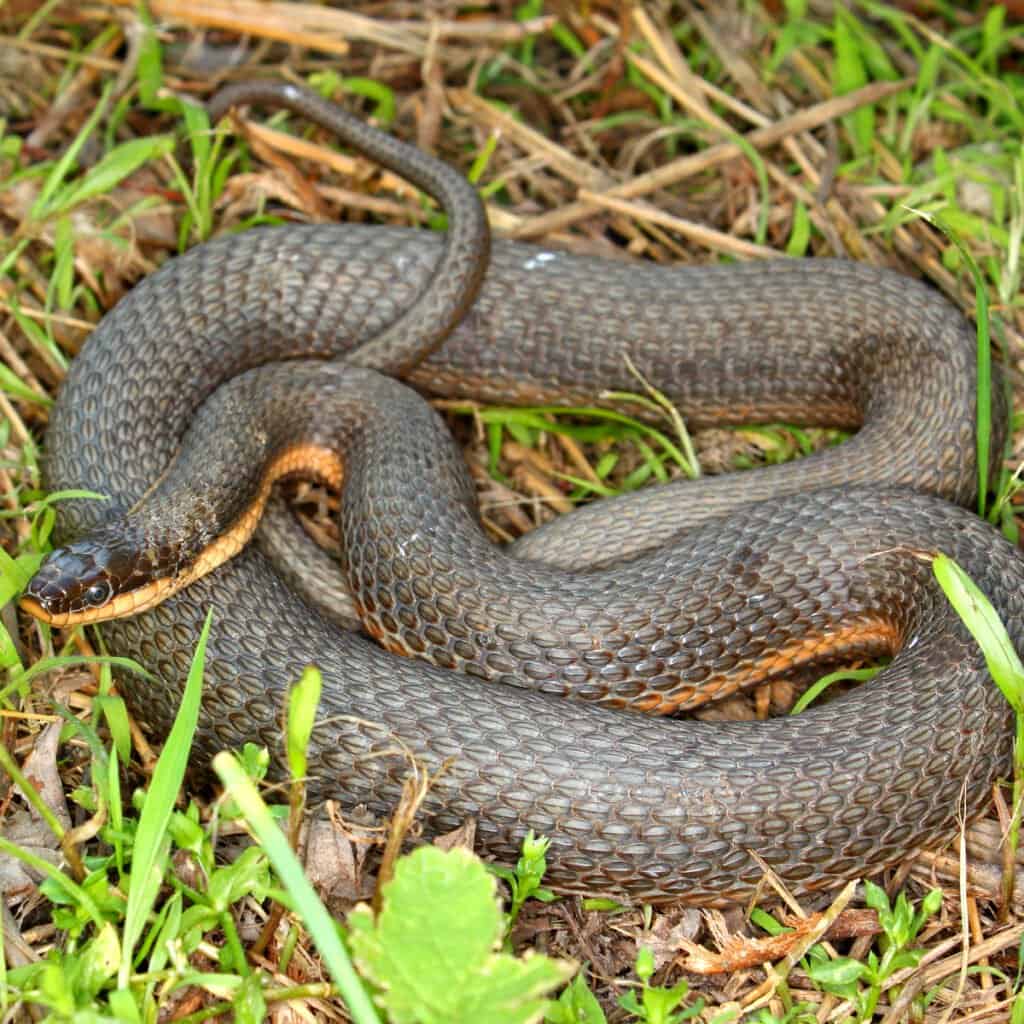
The queen snake is a non-aggressive, nonvenomous snake found in North America.
©Jason Patrick Ross/Shutterstock.com
Crayfish Snake vs. Black Swamp Snake
The top of a crayfish snake can look very similar to that of a black swampsnake, also called Carolina swamp snake. Black swampsnakes, however, are smaller, measuring between 10-15 inches in length. In addition, these snakes are darker, with glossy black scales, and have bright orangish-red bellies.
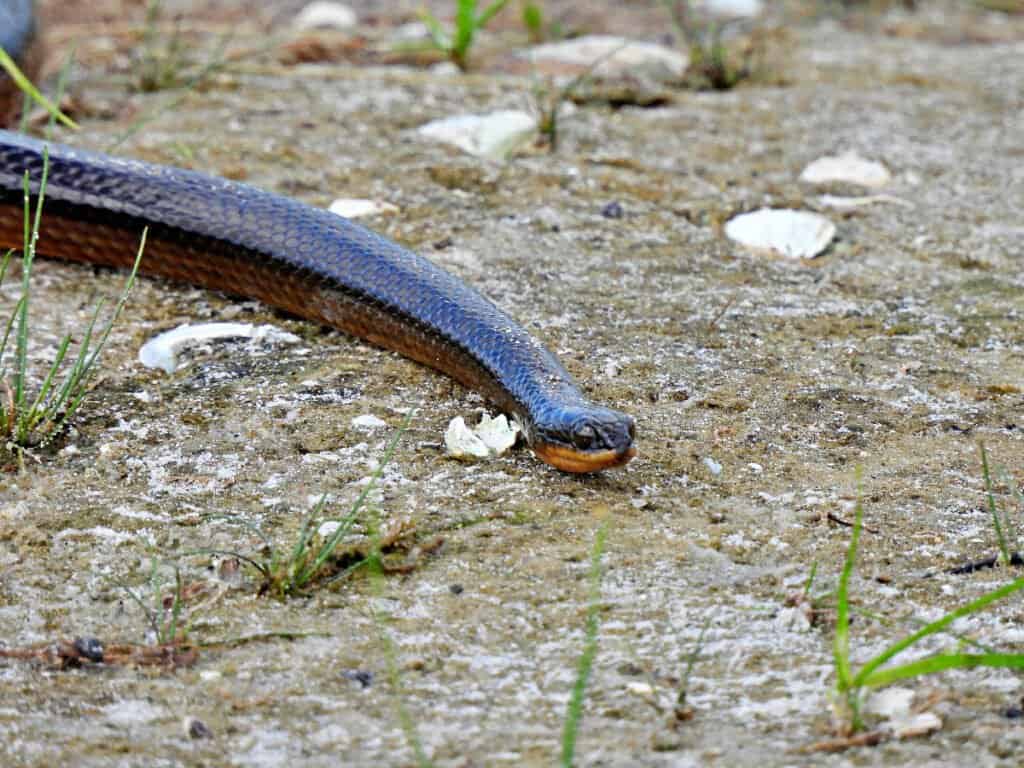
Black swampsnakes measure between 10 and 15 inches in length.
©iStock.com/passion4nature
Other Record-Breaking Snakes
Recently, a record-breaking Burmese python was found in Florida. This massive snake measured 18 feet and 9 inches long, making it the longest python ever captured in the state. It is estimated to have weighed 158 pounds and was caught by researchers at Big Cypress National Preserve while they were surveying for invasive species. The team that located this giant reptile also noted that it contained 122 developing eggs inside its body, which indicates just how healthy the female snake must have been! They believe the snake escaped into the wild and found plenty to eat in the Florida wilderness. This remarkable discovery demonstrates how quickly an exotic species can flourish when given enough room to grow and reproduce without interference from humans or other predators.

Burmese pythons
are solitary animals and only come together to mate in the spring.
©Heiko Kiera/Shutterstock.com
The photo featured at the top of this post is © Nathan A Shepard/Shutterstock.com
Discover the "Monster" Snake 5X Bigger than an Anaconda
Every day A-Z Animals sends out some of the most incredible facts in the world from our free newsletter. Want to discover the 10 most beautiful snakes in the world, a "snake island" where you're never more than 3 feet from danger, or a "monster" snake 5X larger than an anaconda? Then sign up right now and you'll start receiving our daily newsletter absolutely free.
Thank you for reading! Have some feedback for us? Contact the AZ Animals editorial team.







